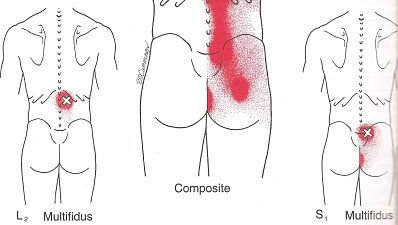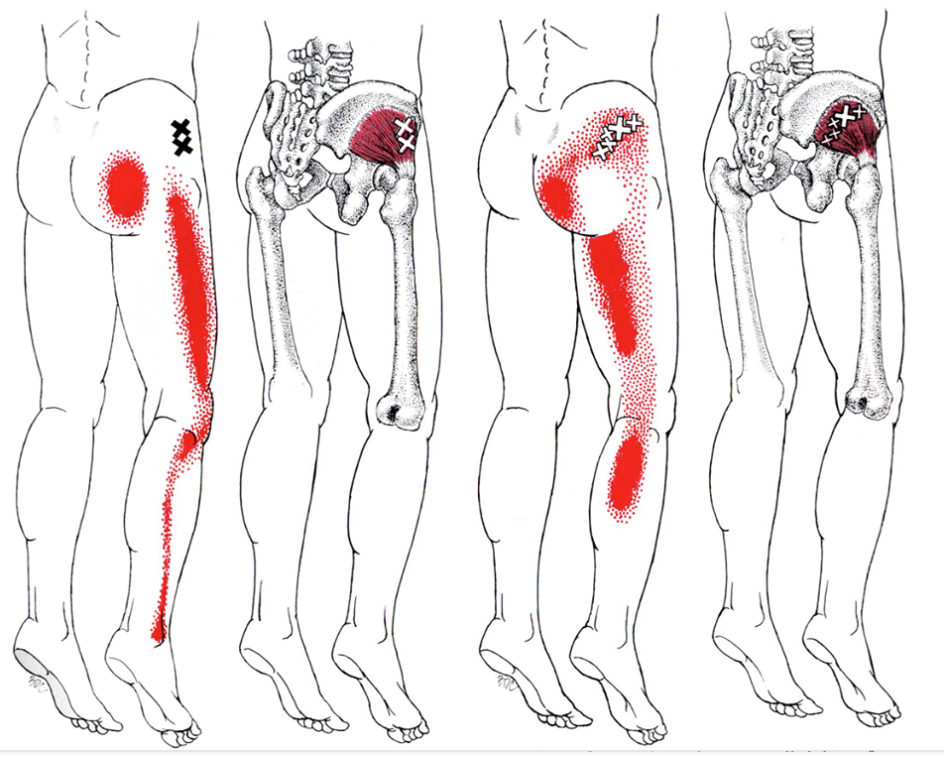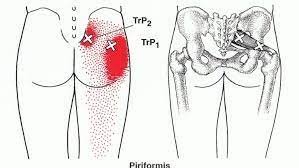Let’s look at how trigger points can cause herniated discs in the lower back. Bulging and herniated discs are relatively common. It is estimated that if we were to MRI the lumbar spines of adults over the age of 30, 7 out of 10 would have bulging or herniated discs. And 4 out of the 7 would still be asymptomatic and have no lower back pain. The most common areas of the lumbar spine to have bulging or herniated discs are the L4-5 segment and the L5-S1 segment, in other words the last two lumbar segments where most spinal stress occurs.
As the muscles become strained in this area, they shorten compressing the vertebra and cause the disc to bulge and eventually herniate due to the stress. At this point, the nerve at this vertebral segment becomes inflamed producing back pain symptoms from active trigger points in the muscles surrounding the vertebra known as the deep paraspinals or Multifidus muscles. The pain at this point will be located mostly in the lower back as illustrated below.
Multifidus Pain Pattern
Muscle Shortening caused by active trigger points will lead to compression of the discs and the facet joints leading to a bulging or herniated disc. The disc will then begin to irritate the nerve at that segment.
Disc Bulge compressing a Lumbar Nerve
Once the nerve is irritated, active trigger points can form in the muscles innervated by that segment. Let’s look at some of the typical trigger points caused by nerve compression at L4/5 and L5/S-1. The L4/5 segment disc will typically begin to irritate the L5 nerve as it exits from the spinal column. The L5 muscles which can be affected include the gluteal muscles, the hip rotators, and the hamstrings. The L5/S1 segment disc will typically irritate the S1 nerve and will affect the S1 muscles such as the calves. Typical trigger point referral patterns will be as follows:
L5 Gluteus Maximus Pain Pattern
L5 Gluteus Medius Pain Pattern
L5 Gluteus Minimus Pain Pattern
L5 Piriformis Pain Pattern
L5 Hamstrings Pain Pattern
S1 Gastrocnemius Pain Pattern
S1 Soleus Pain Pattern
Of course, these are not the only pain patterns caused by L4/5, and L5/S1 disc bulges and herniations. Pain patterns vary and can also be accompanied by numbness, tingling and other nerve symptoms, including weakness in extreme cases. In most cases, a physical therapist can assist you in developing a program to address the trigger points and reduce the disc herniation/ bulge. There are exercise programs which are highly effective in treating trigger points and herniated discs. In about 30% of cases, the affected segment may need special treatment such as trigger point dry needling to deactivate the trigger points enough to allow the disc to reduce and move back into place.
Trigger Point Dry Needling the Multifidus Muscle
Trigger Point Dry Needling is a technique used to treat shortened muscles caused by trigger points. This type of therapy uses a “dry” non-cutting needle, without any injections or medications. The needle is inserted into the active trigger point which is causing the pain resulting in often immediate, dramatic, and lasting improvement.
This treatment is now under the scope of physical therapy and has improved the success rate in treating bulging and herniated discs. The Physical Therapists at Lanier Therapy in Motion have extensive experience and have achieved dramatic results using Dry Needling to correct bulging and herniated discs.
If you feel your pain may be related to a bulging or herniated disc and would like to learn how to treat it successfully without surgery, please take advantage of a free consult at Lanier Therapy in Motion.













